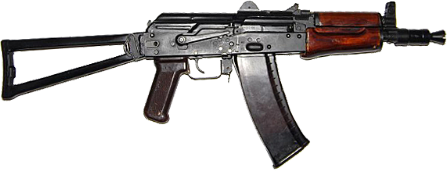






 In 1957, the United States began developing assault rifles for a 5.56 mm cartridge, which was a turning point in the subsequent history of small arms.
In 1957, the United States began developing assault rifles for a 5.56 mm cartridge, which was a turning point in the subsequent history of small arms.
 In the 1960s, a group of Soviet specialists under the supervision of V.M. Sabelnikov developed a 5.45 mm low-pulse cartridge, which was 6 g lighter than the cartridge M1943.
In the 1960s, a group of Soviet specialists under the supervision of V.M. Sabelnikov developed a 5.45 mm low-pulse cartridge, which was 6 g lighter than the cartridge M1943.




 Currently, the Kalashnikov assault rifle is depicted on the coat of arms of Zimbabwe, Mozambique, Burkina Faso and East Timor.
Currently, the Kalashnikov assault rifle is depicted on the coat of arms of Zimbabwe, Mozambique, Burkina Faso and East Timor.
 The assault rifle is assembled under licenses in some countries of Europe, Egypt and Iraq, in China and North Korea.
The assault rifle is assembled under licenses in some countries of Europe, Egypt and Iraq, in China and North Korea.The operation of the AKS-74U is based on the use of the energy of propellant gases tapped from the barrel bore. Upon firing, a portion of propellant gases, pushing the bullet along the bore, is diverted into the gas cylinder through a vent in the barrel wall, exert pressure on the front wall of the gas piston, driving the piston and the bolt carrier with the bolt rearward. The bolt opens the bore, removes the empty case from the chamber and ejects it. The bolt carrier compresses the return spring and cocks the hammer, which is engaged with the auto-sear.
Driven by the return spring, the bolt carrier with the bolt returns to the forward position. The bolt rams a new cartridge into the chamber and locks the bore. The bolt carrier releases the hammer from the auto-safety sear. The hammer is cocked.
The bore is locked by turning the bolt to the right around the longitudinal axis, with its locking lugs entering into the corresponding slots of the receiver.
The AKS-74U fires 5.45 mm rounds with the following types of bullets:
– conventional bullet is designed to engage enemy manpower located in the open or behind obstacles that can be pierced by the bullet. It has a full jacket clad in gilding metal and a steel core covered by a thin lead inlay. Its tip has no distinctive color.
– tracer bullet is intended for target designation and fire adjustment, as well as to defeat enemy manpower. A core is in its nose, and a pressed tracer charge is in the bottom. The bullet has a green tip.
Mikhail T. Kalashnikov was born on November 10, 1919 in the village of Kurya. He was the seventeenth child in a large peasant family. From childhood, he was interested in the design and operation of various mechanisms. At the age of 18, he left his native village and went to Kazakhstan, where he began to work as an accountant at a railway station. In the autumn of 1938 he was drafted into the Red Army in the Kiev Special Military District. After a course of junior commanders, he received the specialty of a tank mechanic and served in the 12th Panzer Division in Western Ukraine.
During the service, he developed an inertial shot counter for a tank gun, an attachment to the Tokarev pistol to increase the efficiency of firing through slits in the tank turret, and a tank’s engine resource counter, which was recommended for serial production.
Following a face-to-face meeting with Georgy Zhukov, he was sent to the Kiev Tank Military Technical School for the manufacture of prototype counters.
He started to participate in the Great Patriotic War in August 1941 as a tank commander with the rank of senior sergeant. In October, in the battles near Bryansk he was severely wounded. At a hospital, he got the idea of creating his own model of automatic firearm, began to make sketches and drawings, comparing and analyzing his own impressions of fighting, the opinions of his comrades in arms, and the contents of the books of the hospital library.
After treatment he received a six-month vacation for recovery. Returning to Kazakhstan, three months later he made a submachine gun prototype. He fabricated an improved model in the training workshops of the Moscow Aviation Institute evacuated to Alma-Ata and presented it to A.A. Blagonravov, an eminent scientist in the field of small arms, the head of the Military Engineering Academy named after F.E. Dzerzhinsky. The scientist noted the originality of the design and recommended that MT Kalashnikov be sent for further training.
Since 1942, M.T. Kalashnikov worked at the Central Small Arms and Mortar Research Range. There in 1944 he created a model of a self-loading carbine, which subsequently served as a prototype for an assault rifle, which he began developing in 1945.
In 1948, he was sent to the Izhevsk Motor Plant to participate in developing technical documentation and organizing the production of the first preproduction lot of his assault rifle.
In 1949, the assault rifle was adopted by the Soviet Army and Kalashnikov was awarded the Stalin Prize and the Order of the Red Star.
Later, dozens of prototypes of automatic small arms were developed at the Izhevsk Machine-Building Plant based on the basis of the Kalashnikov assault rifle.
In 1971, M.T. Kalashnikov was awarded the degree of Doctor of Technical Sciences for his design work and inventions. He is the author of 35 inventions.
In 1999 he was promoted to lieutenant general.
He died on December 23, 2013 in Izhevsk and buried in the Pantheon of Heroes of the Federal Military Memorial Cemetery.
